Paschke Online
Designs Ink Publishing Article Archive and Reference Library
Articles by Chris A. Paschke, CPF GCF
"Yupo Part 2: Mounting Synthetic Papers"
January 2016
Synthetic papers include various grades of plastics: polyvinyl chloride (PVC), polyethylene, polypropylene and polyester/nylon. Tyvek, Yupo, Evolon and TerraSkin are all eco-friendly products that have been developed for use in printing design, marketing, labeling, and packaging, but have also been embraced by artists as a painting and mixed media surface. Yupo—distributed by Legion Paper—is currently the most popular.
Mounting printed ads for temporary publication is simple using high tack pressure-sensitive and rollers; or low temperature, permanent, dry mounting, but framing fine art is another story. Yupo artists are favoring a contemporary look they are referring to as no-framemounting and will most often bring in completed paintings for adhering to a rigid substrate. A number of Yupo instructors are suggesting acrylic gel paste as an adhesive. Fortunately they are usually suggesting this as a prequel to painting, so as not to damage the surface-sensitive finished art.
Gel Mounting
It's a well know fact that liquid acrylic mediums and PVA may be used as wet adhesive within mixed media art for bonding porous materials, but synthetics do not absorb. Smaller pieces of Yupo—under 22x 30"—are being mounted to cradled boxes or 3/8" hardboard using medium. Liquid medium is very lightweight and having no viscosity, soaks into the board leaving little bonding capability for non-absorbent synthetic paper.
Golden Extra Heavy Gel Medium is a thick paste that will bond Yupo to an absorbent rigid substrate, but the end results may not have the desired tear strength. (photo 1) Golden Artist Colors was contacted about use of their gel products for bonding synthetic papers and they firmly stated, they do not endorse the use of their (gel) products with Yupo, and use of it must be considered experimental by nature.
 Photo 1
Photo 1
Golden Extra Heavy Gel—Preliminary wet and spray adhesive tests (clockwise from top). Spray peels from hardboard; gel on EAGLECELL is well bonded but shows slight honeycomb; gel on half of a ½" birch panel bonds well; gel on Sintra easily pulls off.
Bond Failure
It is the incompatibility of materials that allows for bond failure when working with synthetics. The above mentioned gel is a fabulous adhesive for the fusion of porous materials. The gel will bond to the porous substrate—hardboard, panel or box—but cannot aggressively hold to the Yupo allowing it to be pulled from the substrate. The adhesive remains well fused to the board, it's the Yupo bond that lets go. Since Yupo cannot absorb, any guarantee of long term fusion is simply not possible.
The same is true for pressure-sensitive adhesive (PSA). Only select high tack films or self-adhesive products will effectively bond layers for dependable long term fusion. In an attempt to achieve surface smoothness Yupo artists are requesting Gatorboard, Dibond or Sintra as a substrate. Like Yupo, Dibond and Sintra do not absorb so only PSA is an option with Coda Cold-Mount, InstaMount, and Neschen gudy having all tested well with synthetic materials.
P-S Mounting
Neschen gudy802 is a transparent, permanent, high tack, water based, polyacrylate (polyester) PSA film for mounting photos or digital graphics to smooth PVC, Gator, polystyrene, polycarbonate, and aluminum substrates. It is currently being used in Europe for bonding Yupo with rollers to large scale ACM. Gudy 831 uses a long-fiber non-woven paper carrier coated on both sides with high tack, water based, acrylic adhesive, is acid and solvent-free, and has passed the Photographic Activity Test (ISO-18916). When manually applied gudy 831 did not meet tear strength requirements, but with a roller it was aggressive enough for Yupo. (photo 2)
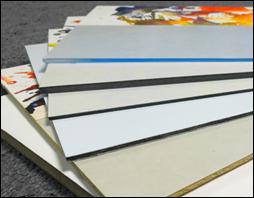 Photo 2
Photo 2
Neschen gudy 831 was pre-mounted to hardboard; ACM; 6mm Black Sintra, ¼" Black Gator; and ⅛" clear acrylic then half was mounted with 74# Yupo using a Drytac JetMounter roller. Left half was then mounted with painted Yupo tester to coated board using same roller.
KoolTack InstaMount is a commercial pressure-sensitive board that has tested well with Tyvek and Yupo, but has not been tested with TerraSkin or Evolon. (photo 3)
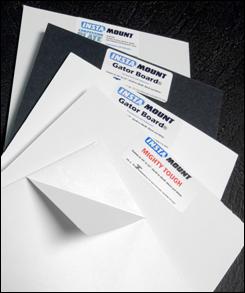 Photo 3
Photo 3
KoolTack InstaMount HT adhesive boards tested well with Tyvek and Yupo, but has not been tested with TerraSkin or Evolon. No other commercial P-S boards held as well.
Though pressure-sensitive adhesives may be manually applied it is ill-advised when applying high tack PSA to smooth substrates. First, the adhesive is aggressive and does not allow for repositioning; second, there are two steps—adhesive to substrate, then art to adhesive—making it difficult to prevent trapped air, and the larger the mount the more difficult the application. And a clean room may be advised to control dust and dirt.
Since smooth feed and consistent motion prevents hesitation lines, avoid using hand crank rollers. Current synthetic papers are available 30and 60wide so roll laminators like D&K Expression 42+; Coda Cold Mount 54or CodaMount Laminator 44—; and Drytac JetMounter 44or 63are all great roller machines.
Dry Mounting
Permanently mounting Yupo is not restricted to cold methods. Since Yupo cannot be used with laser printers many people think it is heat sensitive. Sheet polypropylene has a temperature tolerance of 275ºF with a melt point of 338ºF. In a laser printer, paper passes through rollers in the fuser assembly where heat up to 390ºF to bond plastic toner to paper. A dry mount press is far lower than that, so the question is not the heat, but which HA or P-S adhesive will bond to synthetic paper.
Not all HA boards are Yupo friendly. Testing has verified that 100% polyester—like an encapsulated chart—may bode well on many HA products but polyethylene, polypropylene, polyester and nylon may not. MountCor and MountCor Canvas bond at 130ºF and both love Yupo, Tyvek, and polyester encapsulates. Omega/M&M Heat Activated Mount (HAM) bond at 170ºF; and Bainbridge Heat Activated Foam (HAF) mounts at 160ºF-180ºF, both love synthetic papers, but the maximum ³⁄₁₆HA board thickness is a limitation unless in a frame. Countermounting will be necessary for boards larger than 24x36", even when placed in a float frame.
Open-air display is a flush mount to the edge of the substrate with no protection against surface denting by objects being leaned against it. A strong consideration against HA foam for open-air mounts is the softness of the surface. A float frame helps prevent a painted surface when face down against the floor, but cannot protect contact with edges or corners of other frames when carelessly stacked against a wall.
Heat is not a problem for Yupo but may be a problem with other synthetics so all should be tested prior to mounting. A household iron set on wool shriveled TerraSkin from high heat. (photo 4) The same sample was tested with a tacking iron set temperature and it was fine. HA boards 150ºF should be fine for temperature but might not bond well. If mounting for matting and glazing HA boards should be fine, but ask your artist for a Yupo scrap to test first. Also have them sign a release allowing you to mount their original—if you opt to go there.
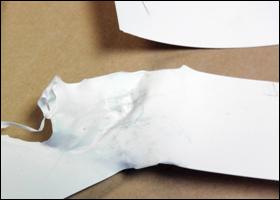 Photo 4: TerraSkin
Photo 4: TerraSkin
TerraSkin recoils badly at highest setting of a clothes iron but is fine with tacking iron. Heat should remain below 150ºF. TerraSkin UV degradable paper marketed as "paper made of stone.
Countermounting
Ansel Adams dry mounted all of his photographs, but he also countermounted all of them with his discarded images. Countermounting is an invaluable technique that stands the test of time. It allows for thinner boards to be used as a substrate by creating equal surface tension on both sides of the mount board to help keep it flat. Wet mounting with heavy gel will expand surface paper fibers causing the board to bow when cured. By mounting the same weight Yupo with the same gel to the back the board will be neutralized and will remain flat.
Coda Cold-Mount pre-coated Gatorboard ¼ and ½ have white adhesive with release liner on the front, and are countermounted with a plastic coating on the back aid against warping, (photo 5) It is a great high tack pressure-sensitive board that loves synthetics and is terrific for Yupo when used with a roll laminator. Thinner boards may still warp without additional float frame support if selected for oversized art.
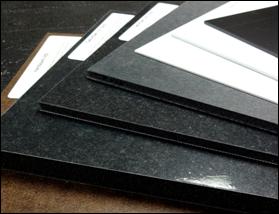 Photo 5
Photo 5
(clockwise- bottom to top) ⅛" hardboard; Coda Cold-Mount Black ½" and ¼" Gatorboard with back coating to counter warping; ¼" Black Gator (no backing); Sintra 3mm, 6mm and 3mm black.
Oversized Substrates
Since Yupo is available 60wide x 10 yd rolls, artists are embracing the oversized format. Hence these 40 x 60" and 48 x 96" originals need to be permanently mounted to rigid panels that will not warp or twist under surface tension.
EnCoreMightyCoreis a durable, rigid, smooth surface foamboard for large pieces that resists bowing and warping.
MightyBull—generally found from sign distributors—combines the dense polystyrene of MightyCore with bright-white polystyrene facers to create an ultra durable board. The smooth, high-impact polystyrene liners are designed for digital and screen printing but are smooth enough for Yupo and PSA. MightyCore is available up to 48 x 96", ½" white and black; MightyBull is ½" white and P-S.
Gilman Ryno Board HD is an extruded high density, high-compressive, polystyrene foamboard with double-think clay coated bright white or black liners. Its rigidity and structural performance offer improved resistance to crushing, warping and denting. All of these foam products are best used within a frame or float frame rather than no frame.
Gatorboardis an extruded polystyrene foam board bonded between two layers of Luxcellwood fiber veneer. Its construction and ½or 1thickness gives it the rigidity for free panel mounting. It is lightweight and available white or black core and self-adhesive from sign suppliers up to 2" thick and 60" X 120". Gator black has the thickness and rigidity necessary for no-frame presentations and the black-edge has been used as a finished look in advertising and display for decades. Yupo artists seem to favor the black core.
Sintrais a lightweight, rigid board of expanded closed-cell polyvinyl chloride (PVC) extruded into a durable sheet for signs, available plain or with PSA. Sintra is not the best choice for fine art due to UV intolerance and yellowing, and may not have the required thickness for large scale support and may still require a backing structure. Generally used for photo mounting it is available 1, 2, 3, 6 and 13mm from sign distributors.
Dibondis an aluminum composite material (ACM) by 3A Composites for sign and display. The panel combines two 3mm aluminum surface layers with a polyethylene core which comes with a protective surface film on both sides making it extremely rigid but rather heavy in large sheets. Cutting requires a table saw, portable saw or band saw but no lubricants, oils or coolants. Sharp edges require smoothing and panels may require a float frame, lifter, or posts for wall mounting.
Substrate Hybrids
And then there are the hybrids, substrate combinations that allow layers to be firmly bonded to each other than reinforced by bonding to a third substrate to better fit the needs of synthetic materials. Large scale 4x 8mixed media paintings require strength, tolerance and longevity with permanent mounts. Yupo mounted with high tack PSA to Dibond or Sintra, in turn bonded to a wood cradle would support large scale no-frame styling. (photo 6) And the hollow back of the wood cradle allows for cleats or other appropriate hardware.
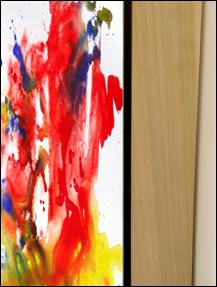 Photo 6: Hybrid Substrate Layering
Photo 6: Hybrid Substrate Layering
Watercolor painted Yupo, mounted with gudy 831 to Dibond (or Sintra), mounted to 2" deep cross-braced wood cradle for large scale "no-frame" styling.
Other options might be PS mounting of Yupo to Sintra or acrylic then using standoffs at regular intervals along the expanse of the panel to maintain support and prevent warping. Contemporary grippers, edge grips and clips allow for standoffs to be decorative while still supporting oversized panels.
Final Mount
Selecting a substrate is only half the problem. A non-absorbent synthetic also requires a compatible adhesive, frame or backing structure, and hanging hardware to all work together for a long term fine art display. It's not the mounting technique or the adhesive that creates the limitations for framing fine art on Yupo, it's the desire of the artist. Frame or rigid panel, glass or open-air, cleat hangers or cradle with wire. It's not longer your father's framing, welcome to the age of thinking outside the frame and realizing that sometimes our 21st century competition may be a sign shop.
END
Copyright © 2016 Chris A Paschke
Resources—Items
http://legionpaper.com—Yupo distribution and information
http://gilmanbrothers.com—MountCor, MountCor Canvas
http://kooltack.com—InstaMount Gatorboard, InstaMount Mighty Tough
http://encoreproducts.com—MightyCore, MightyBull
http://graphicdisplayusa.com—(3A Composites) Sintra, Dibond, Gator
http://codamount.com—Laminators, Cold-Mount Gatorboard
http://dkgroup.com—Expression Wide Format Laminators and SuperStick adhesives
http://drytacusa.com—JetMounter Roll Laminators, HT pressure-sensitive adhesives
http://neschen.com—Neschen gudy 871, 830, 802
http://standoffsystems.com—(Gyford) Standoffs, Grippers, Edge Grips, Clips
http://framewareinc.com—Standoffs
http://conservators-products.com—Beva 371 film
http://www.universityproducts.com—Beva 371 film
For more articles on mounting basics look under the mounting section in Articles by Subject.
Additional information on all types of mounting is found in:
The Mounting and Laminating Handbook, Second Edition, 2002,
The Mounting And Laminating Handbook, Third Edition, 2008 and
Creative Mounting, Wrapping, And Laminating, 2000 will teach you everything you need to know about getting the most from your dry mount equipment and materials as an innovative frame designer.
All books are available from Designs Ink Publishing through this website.
Chris A Paschke, CPF GCF
Designs Ink
Designs Ink Publishing
785 Tucker Road, Suite G-183
Tehachapi, CA 93561
P 661-821-2188
chris@designsinkart.com
 Photo 1
Photo 1 Photo 2
Photo 2 Photo 3
Photo 3 Photo 4: TerraSkin
Photo 4: TerraSkin Photo 5
Photo 5 Photo 6: Hybrid Substrate Layering
Photo 6: Hybrid Substrate Layering